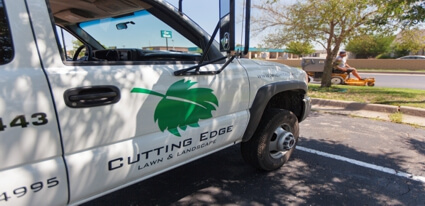
Cooler weather might be slowing your grass growth, but it’s not quite time to put away the yard tools. Fall lawn care is especially important if you want to keep your yard in tip-top shape until next spring.
During the fall, your grass is busy drinking nutrients, moisture, and energy to help it survive the winter. You can give it more of a fighting chance when you follow these top ten fall lawn care tips:
1. Don’t Stop Mowing
Your grass might not grow at the alarming rate it did during the summer, but you should continue to mow it throughout the fall.
As you get closer to winter, drop your lawnmower blade to the lowest setting for the last mow or two. This will help the sun reach the crown of the grass.
2. Water Your Lawn Correctly
Lawns see more dew and moisture and less evaporation during the fall, but that’s not always enough to keep them healthy. Roots need to stay well hydrated throughout the winter,
Use a rain gauge to ensure your grass gets at least one inch of rain per week. If it’s not, rely on your sprinkler or irrigation system.
3. Aerate Your Lawn
The fall is the ideal time to aerate your lawn so that nutrients and water can get to your grass’s roots.
Aerators punch small holes in your soil and extract dirt plugs. This allows for better air flow to help your grass receive more hydration, oxygen, and nutrients.
If you don’t have an aerator, you can usually rent one for around $70 per day. They’re simple to use: turn it on and walk behind it while it does all the work.
4. Rake Your Leaves
It sounds cliche, but there’s a reason most folks rake their yards when fall leaves drop, and it’s not to jump in the piles.
Lingering leaves block sunlight from reaching the grass. They collect moisture and prevent your grass from receiving adequate hydration. If piled on a spot too thick, leaves can eventually kill your grass.
The longer you wait to rake the leaves, the more chance you have of fostering fungal diseases. If raking doesn’t appeal to you, consider upgrading to a lawnmower with a vacuum system.
5. Use Your Leaves for Mulch
Free leaves = free mulch. Once you rake or vacuum all the leaves from your yard, consider “recycling” them.
You can mulch leaves in different ways:
One of the easiest is by using a leaf shredder. It’s an extra investment, but can be worthwhile if you’re purchasing mulch each year.
You could also crush them by running them over with your car, or by using the vacuum system on your lawnmower.
Once you’ve broken up your leaves, bag them and store them in a dry place until the spring.
6. Repair Bare Areas
Those bald spots in your yard will only get worse as it gets cooler. Scratch the surface of the spot with a rake or hoe to loosen the soil. Then use a lawn repair mixture that includes grass seed, fertilizer, and mulch.
You’ll need to water the spot often for the best results, usually every other day for a couple weeks.
7. Control Your Weeds
Weeds are an ongoing bane of house-proud homeowners, and they’re still a problem in the fall.
Fall is the best time to take control of invasive weeds, like dandelions. Like other plants, weeds are trying to soak up as many nutrients as possible to get them through the winter. They’ll be much more responsive to your weed killer now than they were in the spring or summer.
Best of all, using a weed killer now means they won’t return in the spring.
Whatever weed killer you choose, make sure you read the label. Some weed killers require you to use it in the early days of fall when temperatures are generally above 60 degrees.
8. Get Rid of Debris
Leaves aren’t the only debris that will junk up your yard during the fall. While you’re getting your yard ready for cooler weather, take time to remove debris that makes your yard look messy or poorly maintained.
Pick up excess sticks. Clear out unnecessary brush. Get rid of dead or dying plants that likely won’t revive in the spring. Make your yard look neat and tidy going into the fall season.
This isn’t a mandatory part of fall lawn care, but it can help you save time and effort when spring arrives.
9. Don’t Forget to Fertilize
Fertilizer isn’t only to promote growth. Grass and plants can benefit from the sugars in fertilizer to protect roots from freezing temperatures.
This helps the grass to come back healthy in the spring.
Late fall lawn care should include a slow-release fertilizer. A granular 24-0-10 usually contains an ideal amount of nitrogen, phosphorous, and potassium to nourish and protect roots.
However, all lawns vary. You can have your soil professionally tested to see how much of each type of nutrient you need.
The exception to this is if you live near a waterway. Applying fertilizer to grass near the water could lead to the fertilizer contaminating the water source through runoff water.
10. Maintain Your Lawn Tools for Next Year
Taking care of your lawn also means taking care of the tools you use to maintain it. Mowers, weedeaters, rakes, and hedge trimmers require a little love each year to keep them in good working condition.
Make sure that before you store your tools, you clean them and remove any lingering debris. Change the oil, check the air filter, and winterize your lawnmower before storing it.
A little planning and preparation for next year can help you start your spring yard work on a high note.
Need Help with Your Fall Lawn Care?
If you’re eager to say goodbye to your outdoor responsibilities, you can always outsource your fall lawn care to the experts.
Contact Cutting Edge Lawn & Landscaping today for a free quote on getting the fall lawn your neighbors will envy.


